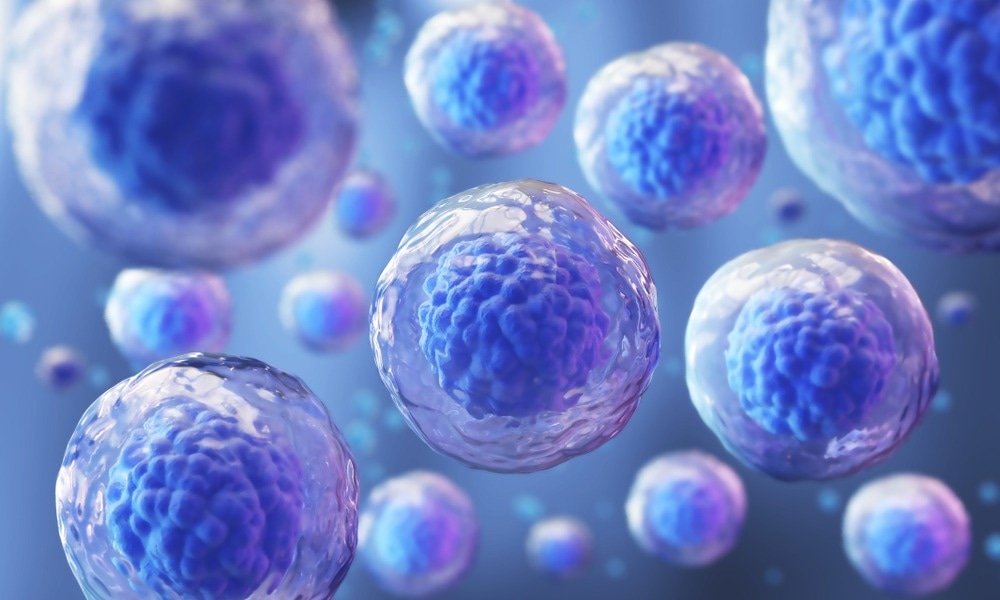Reviewed by Danielle Ellis, B.Sc.Aug 1 2023
It has long been understood that a certain sort of molecular assembly called a “polyelectrolyte complex” aids the cells in maintaining their own organization. The cells employ these complexes, which are excellent at establishing surfaces to keep two liquids apart to establish compartments.

Image Credit: Anusorn Nakdee/Shutterstock.com
These properties have prompted scientists to think of using them for technical purposes, such as improved batteries, water filtration, and even underwater glue, as well as for therapeutic purposes.
But no one understood how the areas inside a polyelectrolyte complex appeared for decades. Positively and negatively charged chains exist, but how do they align? Were they organized in regular alternate lines, or more like what a Russian scientist referred to as “scrambled eggs”?
The internal structure of polyelectrolyte complexes has been described for the first time in a new study from the Pritzker School of Molecular Engineering at the University of Chicago.
Knowing the molecular structure means you can synthesize them and prepare them more precisely, which creates opportunities for applications.”
Juan de Pablo, Senior Scientist, Argonne National Laboratory
Simulations and Scattering
A team of scientists led by de Pablo and Matt Tirrell, dean of the Pritzker School of Molecular Engineering and an Argonne senior scientist, embarked on a year-long investigation to solve the issue.
To begin, postdoctoral researchers Artem Rumyantsev (now on the faculty of North Carolina State University) and Heyi Liang created molecular models and ran thousands of simulations, as well as theoretical calculations based on statistical mechanics, to determine how these molecules would most likely assemble.
Then, a team headed by postdoctoral researcher Angelika Neitzel (now at the University of Florida) and graduate student Yan Fang attempted to produce exact replicas of these molecules in the lab and apply a cutting-edge method to establish their structure.
Neutron scattering is one of the few methods that can be used to observe the minute features of such molecules. To achieve this, beams of neutrons—the neutral particles that make up atomic nuclei—are directed at the molecules, and their patterns are then reconstructed from the neutrons' scattering patterns. However, when doing this, the positively charged and negatively charged chains typically appear the same.
The researchers employed a unique way to identify them differently. Both chains include hydrogen atoms. However, researchers swapped the hydrogen atoms in the positively charged chains with a very slightly different type of hydrogen known as deuterium, which scatters neutrons differently.
Using this method, they discovered that the chains indeed contain unique small-scale repeating patterns while not being rigidly structured across large distances.
‘A Powerful Combination'
The molecular composition of these molecules can be exploited for various purposes, according to the scientists, once it is known. In addition to being crucial for understanding how biology and human body function, polyelectrolyte complexes have special properties that fascinate scientists and engineers.
These droplets still have a lot of water with them, which makes their interfacial tension low—so they tend to encapsulate objects or spread over surfaces and adhere, which are both very useful behaviors. You can use this to deliver drugs in the body, or for things like designing an underwater adhesive.”
Matt Tirrell, Senior Scientist, Argonne National Laboratory
The study, according to Tirrell, serves as an example of how theoretical and experimental scientific teams could collaborate.
He concluded, “It is a very powerful combination of these two approaches. It wouldn’t have happened with either group working in isolation.”
Source:
Journal reference:
Fang, Y. N., et al. (2023). Scattering evidence of positional charge correlations in polyelectrolyte complexes. Proceedings of the National Academy of Sciences. doi.org/10.1073/pnas.2302151120